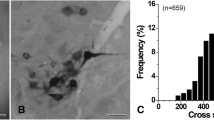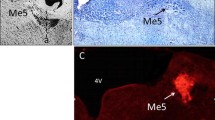Summary
Electron micrographs of the left hypoglossal nucleus of adult male albino rats were quantitatively analyzed from 9–70 days after allowing the transected left hypoglossal nerve to regenerate after an 84 day delay. Delay was achieved by implanting the proximal stump into already innervated sternomastoid muscle, where no regeneration occurred. Regeneration was then allowed by denervating the sternomastoid.
During the regenerative period the initially high number of abnormally electron dense perikarya and dendrites decreased to almost normal values, but no cell removal was seen. This suggested that the degenerate appearance of many profiles after prolonged prevention of regeneration, was reversible.
The neuropil bouton and dendrite counts, and the numbers of synapsing boutons per dendrite, increased steadily to normal values from the low values of suppressed regeneration.
Somatic bouton frequencies, even though already low, decreased further at 32 days, and later increased but not to normal values. The decrease at 32 days coincided with the loss of many subsurface cisterns, and dispersion of Nissl substance, all suggestive of chromatolysis. Later the subsurface cisterns and Nissl substance returned. It was suggested that the delay of complete recovery of somatic bouton frequencies might be because of lack of sensory information from the denervated muscle into which the hypoglossal nerve was regenerating, or because of abnormally low starting values for the recovery phase.
Astrocyte (or, occasionally microglial) sheaths persisted along boutonfree perikaryal surfaces.
Similar content being viewed by others
References
Barron, K.D., Doolin, P.F., Oldershaw, J.B.: Ultrastructural observations on retrograde atrophy of lateral geniculate body. I. Neuronal alterations. J. Neuropath, exp. Neurol. 26, 300–326 (1967)
Barron, K.D., Means, E.D., Larsen, E.: Ultrastructure of retrograde degeneration in the thalamus of rat. I. Neuronal somata and dendrites. J. Neuropath. exp. Neurol. 32, 218–244 (1973)
Cull, R.E.: Role of nerve-muscle contact in maintaining synaptic connections. Exp. Brain Res. 20, 307–310 (1974)
Cull, R.E.: Effect of sensory nerve division on the afferent synapses of axotomised motor neurones. Exp. Brain Res. 22, 421–425 (1975)
Raisman, G.: An ultrastructural study of the effects of hypophysectomy on the supraoptic nucleus of the rat. J. comp. Neurol. 147, 181–208 (1973)
Sumner, B.E.H.: The nature of the dividing cells around axotomized hypoglossal neurones. J. Neuropath. exp. Neurol. 33, 507–518 (1974)
Sumner, B.E.H.: A quantitative analysis of the response of presynaptic boutons to postsynaptic motor neuron axotomy. Exp. Neurol. 46, 605–615 (1975a)
Sumner, B.E.H.: A quantitative study of subsurface cisterns and their relationships in normal and axotomized hypoglossal neurones. Exp. Brain Res. 22, 175–183 (1975b)
Sumner, B.E.H.: A quantitative analysis of boutons with different types of synapse in normal and injured hypoglossal nuclei. Exp. Neurol. 49, 406–417 (1975c)
Sumner, B.E.H.: Quantitative ultrastructural observations on the inhibited recovery of the hypoglossal nucleus from the axotomy response when regeneration of the hypoglossal nerve is prevented. Exp. Brain Res. 26, 141–150 (1976)
Sumner, B.E.H., Sutherland, F.I.: Quantitative electron microscopy on the injured hypoglossal nucleus in the rat. J. Neurocytol. 2, 315–328 (1973)
Sumner, B.E.H., Watson, W.E.: Retraction and expansion of the dendritic tree of motor neurons of adult rats induced in vivo. Nature (Lond.) 233, 273–275 (1971)
Torvik, A., Skjörten, F.: Electron microscopic observations on nerve cell regeneration and degeneration after axon lesions. I. Changes in the nerve cell cytoplasm. Acta neuropath. (Berl.) 17, 248–264 (1971a)
Torvik, A., Skjörten, F.: Electron microscopic observations on nerve cell regeneration and degeneration after axon lesions. II. Changes in the glial cells. Acta neuropath. (Berl.) 17, 265–282 (1971b)
Watson, W.E.: An autoradiographic study of the incorporation of nucleic-acid precursors by neurones and glia during nerve regeneration. J. Physiol. (Lond.) 180, 741–753 (1965)
Watson, W.E.: Some metabolic responses of axotomized neurones to contact between their axons and denervated muscle. J. Physiol. (Lond.) 210, 321–343 (1970)
Watson, W.E.: Some quantitative observations upon the responses of neuroglial cells which follow axotomy of adjacent neurones. J. Physiol. (Lond.) 225, 415–435 (1972)
Watson, W.E.: Cellular responses to axotomy and related procedures. Brit. med. Bull. 30, 112–115 (1974)
Author information
Authors and Affiliations
Rights and permissions
About this article
Cite this article
Sumner, B.E.H. Responses in the hypoglossal nucleus to delayed regeneration of the transected hypoglossal nerve, a quantitative ultrastructural study. Exp Brain Res 29, 219–231 (1977). https://doi.org/10.1007/BF00237043
Received:
Issue Date:
DOI: https://doi.org/10.1007/BF00237043




